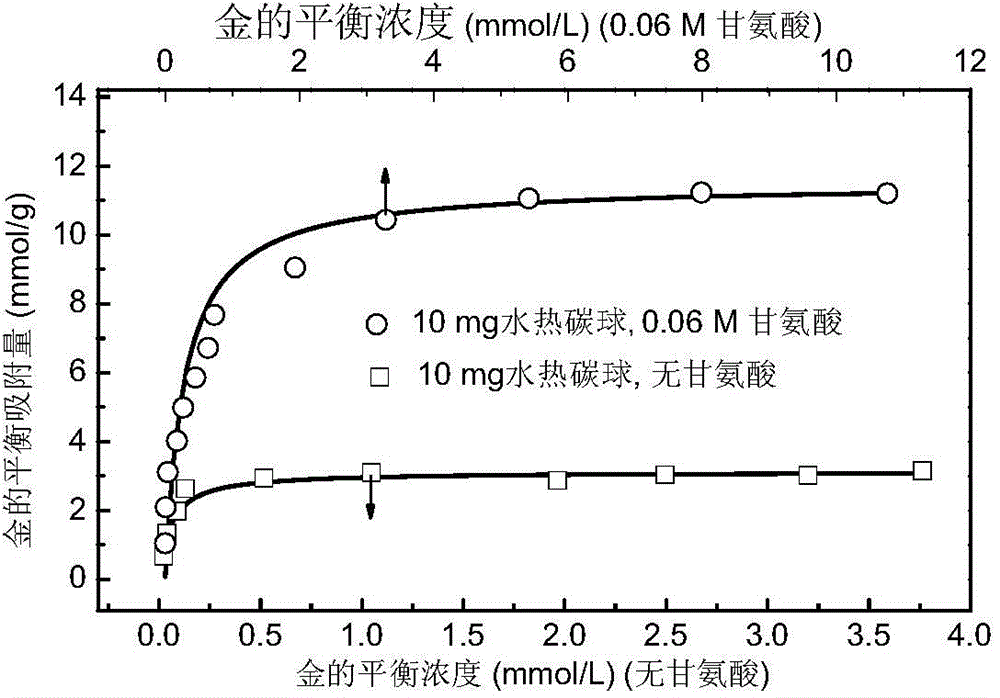Method used for selective recovery of gold in aqueous solutions via reduction and adsorption coupling
An aqueous solution and selective technology, applied in the field of hydrometallurgy, can solve the problems of limited glycine and reduce the effective functional groups of glycine, etc., and achieve the effect of simple preparation process, uniform size and increased loading capacity
- Summary
- Abstract
- Description
- Claims
- Application Information
AI Technical Summary
Problems solved by technology
Method used
Image
Examples
Embodiment 1
[0050] Example 1 Hydrothermal carbon spheres selectively adsorb gold in mixed metal solutions
[0051] 1) Preparation of original solutions of various metal ions: In this study, hydrochloric acid system was taken as an example, a certain mass of chloroauric acid, chloroplatinic acid, rhodium chloride, copper chloride, ferric chloride, cobalt chloride, nickel chloride The solids of palladium chloride and palladium were added into deionized water to dissolve, and the insolubles were removed by filtration to obtain the original solutions of various metal ions, the concentration of which was 1mmol / L.
[0052] 2) Use the solution in 1) as the mother solution, adjust the pH of the solution with HCl and NaOH, and prepare 0.1mmol / L mixed metal solutions with different pH values. The mixed metals include chloroauric acid, chloroplatinic acid, rhodium chloride, and copper chloride. , ferric chloride, cobalt chloride, nickel chloride and palladium chloride.
[0053] 3) Put 10mg of hydro...
Embodiment 2
[0057] When Example 2 is added with or without glycine, the influence of different gold concentrations on the adsorption of gold by hydrothermal carbon spheres
[0058] 1) Preparation of single-component gold ion solution: In this study, the hydrochloric acid system was taken as an example. A certain mass of chloroauric acid solid was dissolved in deionized water, and the insoluble matter was removed by filtration to obtain a single-component solution of 0.1mol / L gold ion.
[0059] 2) Prepare 0.3mol / L glycine solution.
[0060] 3) Put 10mg of hydrothermal carbon sphere metal adsorbent into 13 50mL Jusai Erlenmeyer flasks, add different volumes of chloroauric acid solution prepared in step 1), adjust the pH value to about 6 with HCl and NaOH, and use deionized The water is adjusted to a total solution volume of 10 mL, and the concentration of gold ions in the solution is distributed in the range of 0.1 mmol / L to 5 mmol / L.
[0061] 4) Put 10mg of hydrothermal carbon sphere meta...
Embodiment 3
[0065] Embodiment 3 adds and does not add hydrothermal carbon sphere, the impact of different concentrations of glycine on the recovery rate of gold in aqueous solution
[0066] 1) Preparation of 0.1mol / L chloroauric acid solution: In this study, the hydrochloric acid system was taken as an example. A certain mass of chloroauric acid solid was dissolved in deionized water, and the insoluble matter was removed by filtration to obtain a 0.1mol / L chloroauric acid solution.
[0067] 2) Prepare a glycine solution with a concentration of 1M.
[0068] 3) Prepare chloroauric acid solutions with different concentrations of glycine: add 0.2mL of chloroauric acid solutions prepared in step 1), add different volumes of glycine solutions in step 2), adjust the pH value to about 6 with HCl and NaOH, and use deionized The water was adjusted to a total solution volume of 10 mL to obtain gold solutions containing different concentrations of glycine, a gold ion concentration of 2 mmol / L, and a ...
PUM
| Property | Measurement | Unit |
|---|---|---|
| particle diameter | aaaaa | aaaaa |
| adsorption capacity | aaaaa | aaaaa |
| adsorption capacity | aaaaa | aaaaa |
Abstract
Description
Claims
Application Information
 Login to View More
Login to View More - R&D
- Intellectual Property
- Life Sciences
- Materials
- Tech Scout
- Unparalleled Data Quality
- Higher Quality Content
- 60% Fewer Hallucinations
Browse by: Latest US Patents, China's latest patents, Technical Efficacy Thesaurus, Application Domain, Technology Topic, Popular Technical Reports.
© 2025 PatSnap. All rights reserved.Legal|Privacy policy|Modern Slavery Act Transparency Statement|Sitemap|About US| Contact US: help@patsnap.com



